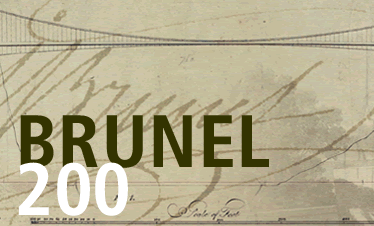
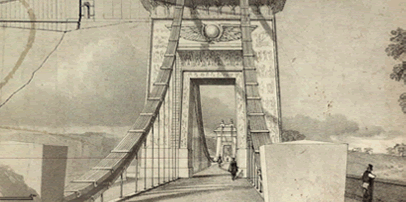
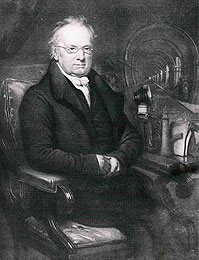
Portrait
of Marc Brunel (ICE)
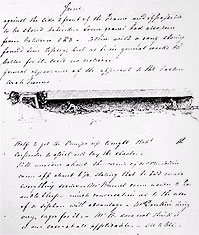
Page
from report by Brunel’s assistant
Richard Beamish (ICE)
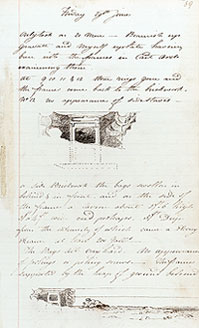
Brunel’s
journal entry 29 June 1827
(University of Bristol)
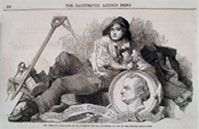
Company
medallion
(University of Bristol)
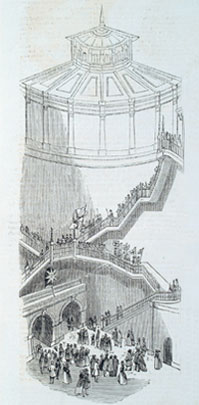
Opening
ceremony
(University
of Bristol)
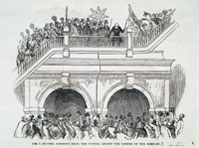
Marc
Brunel bidding farewell to crowd
(University of Bristol)
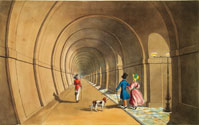
Thames
Tunnel aquatint
(Elton Collection: Ironbridge Gorge
Museum Trust)






The
Thames Tunnel
By the early nineteenth century, congestion in London, particularly around
the busy dockyards in the east, was acute, exacerbated by the presence
of the foul smelling River Thames, which cut the city in two. The construction
of more bridges might have helped relieve the problem but they would need
to be built high enough to allow the passage of ships.
Looking for an alternative, the Thames Archway Company was formed in 1805
with the intention of constructing a tunnel to run beneath the river.
Richard Trevithick, a Cornish miner and engineer, was appointed to supervise
the initial stages, digging a pilot tunnel or driftaway. However, the
traditional method of shoring up the tunnel sides and roof with timber
proved unsuccessful in these difficult conditions and after a series of
floods, the pilot was abandoned just 200ft/61m short of its target. The
Thames Archway Company was dissolved in 1809.
In 1818, Marc Brunel patented a tunnelling shield made from iron, inspired
by the head of the ship-worm which could bore through ship’s timbers.
Miners would work in a series of compartments inside the shield, excavating
sections of earth held back by heavy wooden boards, which were removed
and replaced one at a time to allow access to the face. Meanwhile, bricklayers,
working close behind the shield, would be constructing the tunnel lining.
When all the earth within reach of the boards had been dug out, the shield
could be moved forward to begin the process again.
Convinced that the shield made the scheme to build a tunnel beneath the
Thames a feasible proposition, the Thames Tunnel Company was formed in
1824 with Marc Brunel appointed as chief engineer. Work began near the
church of St Mary’s Rotherhithe in March 1825. A huge cylinder of
brickwork, 50ft/15.24m in diameter and 42ft/12.8m high, was built upon
an iron ring. As the brickwork was completed, workmen dug away the ground
inside and beneath the ring. The weight of the bricks caused the cylinder
to slowly sink until its top reached ground level. The tunnelling shield
was then lowered into the shaft to begin its laborious progress beneath
the river.
It had been assumed that the miners would encounter firm clay throughout
their passage but the shield soon struck loose gravel and sand mixed with
rotting sewage, making the work even more dangerous and difficult than
expected. The foul air in the tunnel caused fevers and blindness. One
victim was William Armstrong, the engineer-in-charge, who suffered serious
illness. He resigned and Marc’s son Isambard was promoted to replace
him. Eager to prove himself, Brunel often spent days at a time underground,
taking only short naps between shifts, lying on a bricklayer’s stage
beside the shield. Fearful for his health, Marc assigned him three assistants
in a vain attempt to reduce his punishing workload: one died of fever,
another lost his vision in his left eye.
Although the bricklayers worked fast, there was always a risk that the
water would break through the unsupported gap beneath the riverbed that
was exposed each time the shield was moved forward. On 18 May 1827, the
river burst in and a great wave rushed through the tunnel. Fortunately,
the men had time to reach the shaft and were able to climb the stairs
to the surface before the tunnel flooded. Displaying his typical bravery,
Brunel rescued an old man who was struggling in the rising water by sliding
down an iron tie rod and securing a rope around the man’s waist.
Within 24 hours, Brunel was inside a diving bell, borrowed from the West
India Dock Company, inspecting the hole in the tunnel roof that had caused
the flood, one foot resting on the completed brickwork, the other on the
shield. His companion lost his hold upon the diving bell and had to grab
Brunel’s extended foot to avoid disappearing down the hole to a
certain death. Brunel dragged him back up and returned to the surface
before descending once more to continue his inspection. Later, when the
hole was filled with a combination of iron rods and bags of clay, Brunel
was the first to reach the shield, initially by boat on the floodwaters
and then by crawling over the bank of earth the river had washed in. In
his diary he wrote:
What a dream it now appears to me! Going down in the diving bell,
finding and examining the hole!... The novelty of the thing, the excitement
of the occasional risk attending our submarine
excursions, the crowd of boats to witness our works all amused –
the anxious watching of the shaft – seeing it full of water, rising
and falling with the tide with the most provoking regularity...
Work resumed in November, an occasion marked by a banquet held within
the tunnel, but disaster struck again in January 1828 when water burst
in with even greater ferocity. Brunel was standing in the shield at the
time and was swept away. He was trapped beneath a fallen timber, which
damaged his knee and caused internal injuries. Managing to free himself,
he waited and called out for the men he thought had been lost beneath
the collapsed staging. He later wrote:
While standing there the effect was – grand – the roar
of the rushing water in a confined passage and by its velocity rushing
past the opening was grand, very grand. I cannot compare it to anything,
cannon can be nothing to it. At last it came bursting through the opening.
I was then obliged to be off – but up to that moment, as far as
my sensations were concerned, and distinct from the idea of the loss of
the six poor fellows whose death I could not then foresee, kept there.
The sight and the whole affair was well worth the risk and I would willingly
pay my share, £50 about, of the expenses of such a ‘spectacle’.
With his injuries, Brunel’s association with the tunnel ended. Although
Marc was again able to fill the breach, work came to a halt as the finances
were exhausted and business confidence in the project was lost.
Marc persevered and work finally resumed in 1835. The Thames Tunnel was
opened to the foot traffic on 25 March 1843. It was the first tunnel to
be built under a navigable river and hailed as the eighth wonder of the
world. In 1869, it was converted to carry the East London Railway. Today
around 14 million passengers travel through it each year.
